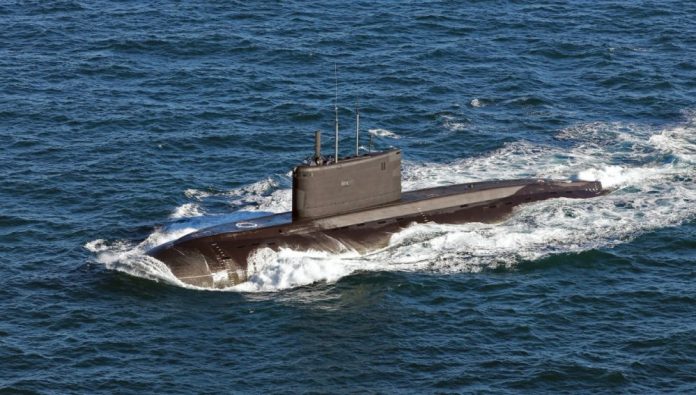At least one Russian Kilo class submarine made a surface transit Tuesday from the port of Novorossiysk to Sevastopol under heavy escort. The heightened security alludes to the potential danger for attacks from Ukrainian drones and unmanned ordinance. It goes without saying that it is extremely unlikely for a high value asset like a submarine to travel via the surface where it can easily be spotted, tracked, and targeted by NATO and Ukrainian intelligence services.
The submarine is likely enroute to be loaded with 3M-54 Kalibr cruise missiles for use against targets in Ukraine.
The Kilo Class Submarine is a diesel powered attack submarine mainly used for anti-shipping and anti-submarine warfare. It can also be fitted with cruise missiles for use on land targets, which has been the case throughout much of the wars in Ukraine and Syria. There are at least seven diesel-powered attack submarines in the Russian Black Sea Fleet, though it is unknown which exact ship this one is.
One can speculate as to a number of reasons the submarine may have sailed on the surface as opposed to being much safer and mostly undetected under the water, most of which include some sort of serious damage or mechanical failure. Sailing on the surface, even while heavily guarded as in this case, exposes the submarine to enemy intelligence gathering, route interdiction, or even possible attacks. In the case of the latter, the Ukrainian military has made common use of Unmanned Surface Vehicles (USVs) to bring the fight to Russian warships off the coast. One such attack saw a single 18 foot USV sink or cause damage to several Russian ships, with similar attacks harassing the Russian Navy throughout the Black Sea. The Ukrainians also have success using the TB-2 Bayraktar Unmanned Combat Aerial Vehicle (UCAV) and Neptune anti-ship missiles, both being used to sink the Russian Black Sea fleet flag-ship, Moskva, in April.
Opening submarines to the potential of any of these weapons is a major risk that no commander would take without necessity, hinting at the fact that the submarine likely underwent some sort of damage or significant mechanical failure bad enough to keep it from diving to safety.
It should also be noted that most traditional diesel submarines have to occasionally surface to charge their batteries, however that is an unlikely reason to sail such a long distance surfaced.
Further updates will follow if open-source intelligence reports any maintenance or repairs on the submarine.



